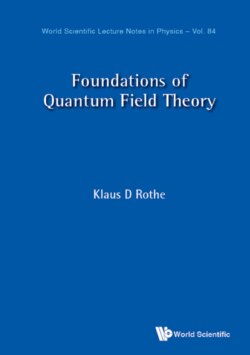Foundations of Quantum Field Theory

Реклама. ООО «ЛитРес», ИНН: 7719571260.
Оглавление
Klaus D Rothe. Foundations of Quantum Field Theory
PREFACE
Chapter 1. The Principles of Quantum Physics
1.1Principles shared by QM and QFT
1.2Principles of NRQM not shared by QFT
Group-property
Boosts
Chapter 2. Lorentz Group and Hilbert Space
2.1Defining properties of Lorentz transformations
2.2Classification of Lorentz transformations
General form of a Lorentz boosts
2.3Lie algebra of the Lorentz group
2.4Finite irreducible representation of
2.5Transformation properties of massive 1-particle states
2.6Transformation properties of zero-mass 1-particle states
Chapter 3. Search for a Relativistic Wave Equation
3.1A relativistic Schrödinger equation
3.2Difficulties with the wave equation
Probability interpretation
3.3The Klein–Gordon equation
3.4KG equation in the presence of an electromagnetic field
Negative energy solutions and antiparticles
Probability interpretation
Chapter 4. The Dirac Equation
4.1Dirac spinors in the Dirac and Weyl representations
Dirac equation: historical derivation
Tracelessness
Dimensionality
Minimal dimension
Dirac spinors in the Weyl representation
4.2Properties of the Dirac spinors
4.3Properties of the γ-matrices
4.4Zero-mass, spin = fields
Chirality
Solution of Weyl equations
4.5Majorana fermions
Majorana representation
Majorana spinors
Self-conjugate Dirac fields
Chapter 5. The Free Maxwell Field
5.1The radiation field in the Lorentz gauge
5.2The radiation field in the Coulomb gauge
Chapter 6. Quantum Mechanics of Dirac Particles
6.1Probability interpretation
6.2Non-relativistic limit
6.3Negative-energy solutions and localization
6.4The Klein Paradox
6.5Foldy–Wouthuysen Transformation
Chapter 7. Second Quantization
7.1Fock-space representation of fields
7.2Commutation relations
7.3P, C, T from equations of motion
7.4P, C, T in second quantization
Chapter 8. Canonical Quantization
8.1Lagrangian formulation and Euler–Lagrange equations
8.2Canonical quantization: unconstrained systems
8.3Canonical quantization: constrained systems
Dirac algorithm
8.4QED as a constrained system
Gauge transformations
Dirac brackets
Chapter 9. Global Symmetries and Conservation Laws
9.1Noether’s Theorem
9.2Internal symmetries
9.3Translational invariance
9.4Lorentz transformations
Chapter 10. The Scattering Matrix
10.1The S-matrix and T-matrix
10.2Differential cross-section
10.3LSZ reduction formula
Chapter 11. Perturbation Theory
11.1Interaction picture and U-matrix
11.2Interaction picture representation of Green functions
Some formal considerations
11.3Wick theorems
Wick theorem No. 1
Corollary to Wick theorem No. 1
Wick theorem No. 2
Corollary to Wick’s theorem No. 2
Wick theorem No. 3
11.42-point functions
Basic definitions
Fourier representations
Causality
Table of 2-point functions of free scalar, fermion and Maxwell fields
(I) Scalar field
(II) Fermion field
(III) Gauge-field in Coulomb gauge
11.5Feynman Diagrams for QED
Diagrammatic representation of V
Cancellation of vacuum diagrams
Second order Fermion propagator of QED
Second order photon propagatorof QED
Topologically equivalent diagrams
11.6Furry’s theorem
Furry’s theorem
11.7Going over to momentum space
Electron and photon 2-point function in momentum space
11.8Momentum space Feynman rules for QED
11.9Moeller scattering
Moeller scattering in space-time
The T-matrix
11.10The Moeller differential cross-section
Differential cross-section in center of mass (cm)-system
11.11Compton scattering
Chapter 12. Parametric Representation of a General Diagram
12.1Cutting rules for a general diagram
12.2An alternative approach to cutting rules
12.34-point function in the ladder approximation
Chapter 13. Functional Methods
13.1The Generating Functional
13.2Schwinger’s Construction of [j]
The interacting case
13.3Feynman Path-Integral
Path-integral representation of free propagation kernel in QM
Checking the use of the completeness relation
Semi-classical derivation for the free-particle kernel
Path integral representation of kernel with interaction
13.4Path-integral representation of correlators in QM
Digression: Harmonic oscillator
Back to (13.32)
13.5Feynman path-integral representation in QFT
Perturbation Theory recovered
13.6Path-Integral for Grassman-valued fields
Grassmann Algebra
Integration over Grassmann variables
Differentiation of Grassmann Variables
13.7Extension to Field Theory
13.8Mathews—Salam representation of QED generating functional
13.9Faddeev–Popov quantization andα-gauges
Aμ-propagator in α-gauges
Chapter 14. Dyson–Schwinger Equation
14.1Classification of Feynman Diagrams
Tree graphs
Connected diagrams
1-particle irreducible (1PI) diagrams
14.2Basic building blocks of QED
14.3Dyson–Schwinger Equations
Chapter 15. Regularization of Feynman Diagrams
15.1Pauli–Villars and dimensional regularization
Pauli–Villars regularization
Dimensional regularization
15.1.1Electron self-energy
Pauli–Villars regularization
Dimensional regularization
15.1.2Photon vacuum polarization
Pauli–Villars regularization
Dimensional regularization
15.1.3The vertex function
Pauli–Villars regularization
Dimensional regularization
Chapter 16. Renormalization
16.1The principles of renormalization
16.2Renormalizability of QED
16.2.1Fermion 2-point function
16.2.2Photon 2-point function
16.2.3Vertex function
16.3Ward–Takahashi Identity and overlapping divergences
Renormalized Ward–Takahashi identity
The problem of overlapping divergences in QED
16.41-loop renormalization in QED
ComputationZA and πren(k2)
Computation of Z1 and Γμ(p, p′)ren
16.5Composite operators and Wilson expansion
16.6Criteria for renormalizability
Theorem
16.7Taylor subtraction
Renormalization by Taylor subtraction
16.8Bogoliubov’s recursion formula
16.9Overlapping divergences
16.10Dispersion relations: a brief view
Källen–Lehmann representation
The analytic approach
Cutcosky rules
Chapter 17. Broken Scale Invariance and Callan–Symanzik Equation
17.1Scale transformations
17.2Unrenormalized Ward identities of broken scale invariance
17.3Broken scale invariance and renormalized Ward identities
17.4Weinberg’s Theorem
17.5 Solution of CS equation in the deep euclidean region
17.6Asymptotic behaviour of Γ and zeros of the β-function
17.7Perturbative calculation of β(g) and γ(g) in ϕ4 theory
ϕ4 beta-function
17.8QEDβ-function and anomalous dimension
17.9QEDβ-function and leading log summation
17.10Infrared fix point of QED and screening of charge
Chapter 18. Renormalization Group
18.1The Renormalization Group equation
Explicit expressions to order
18.2Asymptotic solution of RG equation
Chapter 19. Spontaneous Symmetry Breaking
19.1The basic idea
19.2More about spontaneous symmetry breaking
19.3The Goldstone Theorem
Goldstone Theorem:
19.4Realization of Goldstone Theorem in QFT
Evasion of the Goldstone Theorem
Chapter 20. Effective Potentials
20.1Generating functional of proper functions
Generating functional of proper Green Functions
20.2The effective potential
20.3The 1-loop effective potential ofϕ4-theory. 1-loop approximation
20.4WKB approach to the effective potential
20.5The effective potential and SSB
RG equation forVeff
Index
Отрывок из книги
Foundations of Quantum Field Theory
ISSN: 1793-1436
.....
14.1Classification of Feynman Diagrams
14.2Basic building blocks of QED
.....